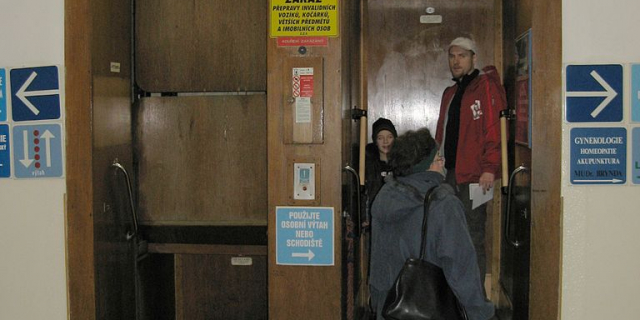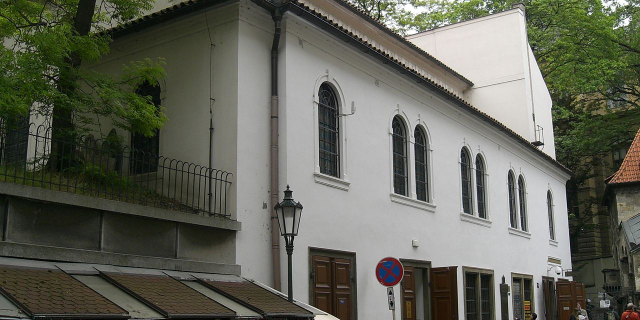Staroměstský orloj
( Prague astronomical clock )The Prague astronomical clock or Prague Orloj (Czech: Pražský orloj [praʃskiː orloj]) is a medieval astronomical clock attached to the Old Town Hall in Prague, the capital of the Czech Republic.
The clock was first installed in 1410, making it the third-oldest astronomical clock in the world and the oldest clock still in operation.
 The clock tower
The clock towerThe oldest part of the Orloj, the mechanical clock and astronomical dial, dates back to 1410, when it was created by clockmaker Mikuláš of Kadaň and Charles University professor of mathematics and astronomy Jan Šindel. The first recorded mention of the clock was on 9 October 1410.[1] Later, presumably around 1490, the calendar dial was added and the clock facade was decorated with gothic sculptures.
Formerly, it was believed that the Orloj was constructed in 1490 by clockmaster Jan Růže (also called Hanuš); this is now known to be a historical mistake. A legend, recounted by Alois Jirásek, has it that the clockmaker Hanuš was blinded on the order of the Prague Councillors so that he could not repeat his work; in turn, he disabled the clock, and no one was able to repair it for the next hundred years.
In 1552 it was repaired by Jan Táborský (1500–1572), master clockmaker of Klokotská Hora, who also wrote a report of the clock where he mentioned Hanuš as the maker of this clock. This mistake, corrected by Zdeněk Horský,[2] was due to an incorrect interpretation of records from the period. The mistaken assumption that Hanuš was the maker is probably connected with his reconstruction of the Old Town Hall in the years 1470–1473. The clock stopped working many times in the centuries after 1552, and was repaired many times. The legend was used as the main plot in the 2008 animated film Goat story – The Old Prague Legends.
In 1629 or 1659 wooden statues were added, and figures of the Apostles were added after a major repair in 1787–1791. During the next major repair in the years 1865–1866 the golden figure of a crowing rooster was added.
The Orloj suffered heavy damage on 7 and especially 8 May 1945, during the Prague uprising, when the Nazis fired on the south-west side of the Old Town Square from several armoured vehicles in an unsuccessful attempt to destroy one of the centers of the uprising. The hall and nearby buildings burned, along with the wooden sculptures on the clock and the calendar dial face made by Josef Mánes.[3] After significant effort, the machinery was repaired, the wooden Apostles restored by Vojtěch Sucharda, and the Orloj started working again in 1948.[4]
The Orloj was renovated in autumn 2005, when the statues and the lower calendar ring were restored. The wooden statues were covered with a net to keep pigeons away.
The last renovation of the astronomical clock was carried out from January to September 2018, following a reconstruction of the Old Town Tower. During the renovation, an electric clock mechanism that had been in operation since 1948 was replaced by an original mechanism from the 1860s.[5]
600th anniversaryOn 9 October 2010, the Orloj's 600th anniversary was celebrated with a light show on the face of the clock tower. Two projectors were used to project several animated videos on the clock. The videos showed it being built, torn down, rebuilt, and peeled away to show its internal mechanisms and the famous animated figures, as well as various events in the clock's history. The video interacted with the tower's architecture, such as rain rolling off the arch, and showing the passage of time with moving shadows.[6]
605th anniversaryOn its 605th anniversary, 9 October 2015, the Orloj appeared on the Google home page as a Google Doodle.[7][8]
2018 reconstructionThe Orloj was taken down for reconstruction and replaced by a LED screen in early 2018, with the restoration works scheduled to last for the whole summer tourist season of 2018 and the restored actual Orloj eventually being back in service soon enough to commemorate the 100th anniversary of Czechoslovakia at the end of October 2018.[9][10] With the reconstruction and restoration work completed, it resumed operations at 6 p.m. local time on 28 September 2018.[11][12]
2022 reconstruction controversyThe artwork on the Orloj became the center of controversy after a local heritage group noticed the reproduction had "radically changed the appearance, ages, skin tone, dress and even genders of the figures" illustrated by Mánes in 1866.[13] A member of the Club for Old Prague, Milan Patka, registered a complaint with the Ministry of Culture, alleging that in the restoration, painter Stanislav Jirčík had deviated from the "spirit and detail" of the original.[14] The National Heritage Inspectorate began investigations into the allegations.
The Guardian reported that the artist may have put the likenesses of his friends and acquaintances into the work, "possibly as a joke."[15] Upon this discovery, the Prague city council's deputy mayor for transport and heritage criticized the botched restoration as "banal and done by an amateur" and suggested the city might need to commission a replacement. It is not yet known how the restoration's discrepancy with the original had escaped detection when the work was installed in 2018.





























Add new comment